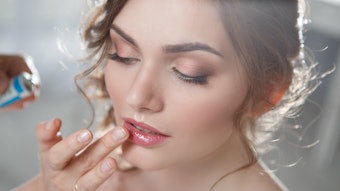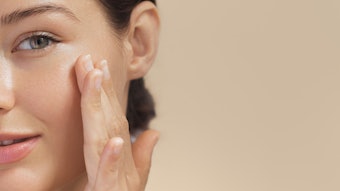
When articles are written about how to choose flattering eyeshadow colors, the choices are generally based on eye color. Eye color can be enhanced with a version of almost any color. What is more important is the combinations of the colors that are chosen, and to always consider the hair color. If evening foundation is done correctly with lasting coverage, the undertone can be manipulated at will, and the augmentation will go undetected in dim evening light. The hair frames the face and impacts color, and should always be considered when doing makeup for any lighting.
Makeup in Evening Light
Evening lighting is much more subdued than daylight, making contouring and definition required to define the facial features, especially the eyes. Be sure not to overemphasize every feature or the result can still become overdone and garish.
For evening lighting, be sure to use a mix of textures and values. Matte colors will not reflect light, so they are best used to create a recessed area. A satin texture will reflect some light and create a mid-level reflection. Shimmer should be used to highlight the high points of the eyes and face that the individual would like to emphasize. This is generally: at the top of the cheekbone, under the brow, on the eyelid or on the tear duct.
More shimmer can be used at night due to low lighting.
The complexion should be matte overall to avoid a greasy look; however, more shimmer can be used at the top of the cheekbone due to the low lighting. Candlelit settings tends to subdue cool colors and wash out the warmer hues, so all of the warm shadow colors such as peach, ivory and warm brown hues will be soft to invisible. The cool colors such as mauves, blues and violets will be softer and more muted, but more visible than warm colors. The cool colors that are exacerbated by CFL bulbs and UV rays during the day are muted in evening light, providing soft elegant or dramatic looks without being over the top.
Warm Brunettes
For a natural day look, analogous colors are used. Since the tone of warm brown is orange based, related colors are chosen such as coppers, golds, rust, peach, ivory, etc. These colors will be softer in harsh UV light, and coordinate with all of the warm tones in the hair.
For the evening, incandescent lighting is soft. A dramatic evening look needs to incorporate enough cool tones to show up under romantic candlelight without clashing with the warm highlights emanating from the hair that frames the face. For evening eyes, go to the opposite side of the color wheel and use a complimentary palette, just don’t get too blue or purple. Try neutral versions such as violet, plum, raison, cabernet, eggplant, etc. Use eyeliners in black/brown, deep raison or black plum. Choose highlight colors in pale yellow, gold or ivory.
Black Haired Beauty
Black hair radiates a blue aura around the face, making oranges, red/coppers and yellow golds too much of a contrast, especially during the day. Evening light will add even more yellow to these colors.
For evening eyes, try pairing antique greenish/golds, silvers or platinum highlights with satin taupe, cool beiges and gray/browns. Contour with black, black/brown, hunter green, navy, or dark charcoal. Violets, mauves and purples will also pair nicely, because the dark hair will provide balance to the heavier pigment on the eyes, and candlelight will subdue the cool tones even more. So feel free to add plenty of dark contour and liner based on eye shape.
Blondes
For cool blonde hair, you can highlight with icy pastel pinks and champagnes. Hair with ashy, platinum or champagne highlights looks great when the eyes are accented with like highlights. Blend well with cool satin mid-tones such as gray, taupe, mauve, bone, beige, mint or lavender contoured with matte black, charcoal, eggplant, mink or dark green.
For golden blonde hair, opt for salmon or peachy pinks, gold and ivory based highlights. The bronze goddess look is always great for golden blondes, just glam it up a bit more for evening by smudging the coppers and bronze with dark brown smoky liner, and finishing it off with a black gel or liquid liner.
Cool to Neutral Hair, Blue Eyes
Put pastel powder gray/blue on the eyelid (stippled in for an opaque look) Place champagne or shimmery white under the brow and tear duct. Satin light taupe goes in the crease; use a medium density blending brush to blend crease and under brow area. Satin medium/deep taupe can be applied in the crease. Use a medium size crease brush and blend inside of the light taupe.
Dark black/brown matte color should be applied with a small crease brush inside the medium taup, and blended with a smaller firmer blending brush to soften the edge of the darkest crease color. Use black or black/brown liner and line the eyes based on eye-shape, set with a brown/black shadow and sweep into a V in the crease. Smudge a mid-tone shadow of a grey/taupe and blend. Take a small smudge brush and apply a drop shadow under the eye too, taper closer to the lash line nearing the tear duct area. Add extra white or champagne shimmer on high points and tear duct area and blend, blend, blend.
Don't Forget Eyeliner
Apply liner based on eye shape. If the eyes are on an even plane, a wing will look elegant for evening. The larger the eyelid, the thicker the liner can be. Try a cut crease with well blended colors from the same family.
If the lid is smaller, tight-line the eye, and gradually thicken the liner starting from the center of the eye lifting up and out, and tapering off toward the outer edge of the eye. If the eyes are droopy or hooded, use an upward wedged liner or smudge it into a reversed C. Be sure to have the eyes open when assessing where the new crease should be placed, so it is incorporated and not eclipsed by the hooded tissue. Smudge the liner onto the apex of the hood, leaving enough room to blend softer and lighter colors fading up and out. Make sure the edges are well blended in an upward rounded fashion, so they don’t droop down or have harsh angles.
Use the anonymity of the night to let your imagination run wild and express your creativity. In ambient lighting anything is possible

Lisa Shor is the director of makeup education for The Art Institute of Makeup, a division of the New Age Spa Institute (a CIDESCO-accredited school). In addition, she is a licensed esthetics educator and a member of the editorial team at The New Age Spa Institute. Shor has done corrective camouflage makeup on all skin maladies and has taught the class nationally, as well as orating at international trade shows and performing practical demos. She can be contacted at [email protected]










